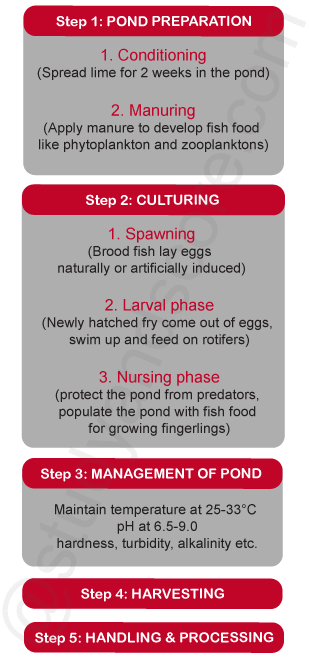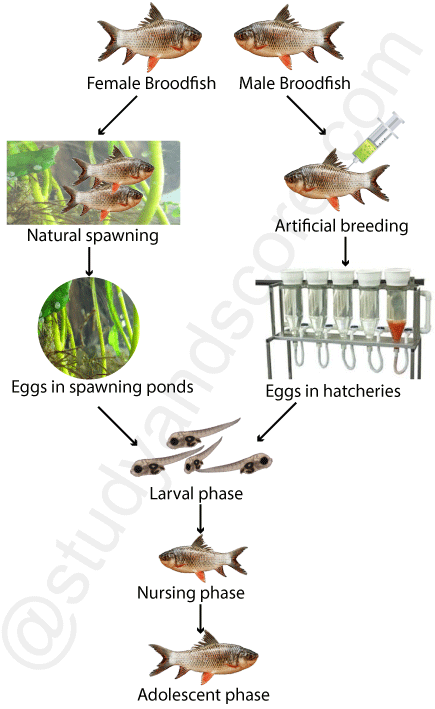Fish farming is the raising of fish for commercial purpose. Based on the environment in which culture is done, fish farming may be categorized as freshwater or brackish water or saltwater or marine fish farming. Carp culture is the oldest form of aqua culture known to the world. Currently two-thirds of the fish produced is carp. The Cyprinidae are the family of freshwater fishes, which includes the carps and their relatives. This family is commonly known as "carp family". Cyprinidae is the largest known fish family and the largest vertebrate animal family. The family name is derived from the Ancient Greek word carp.
The following are the species of carp fishes referred by their geographic origins.
Grass carp
Silver carp
Bighead carp
Black carp
Mrigala
Catla-Catla
Rohu
Carps have been the backbone of aquaculture practice in India and it is the three Indian major carps viz., Catla, Rohu and Mrigal together with three other exotic carps viz., silver carp, grass carp and common carp contribute over 85% of the aquaculture production of the country.
The distinguishing characters of carps which make it most suitable for culture are,
The following criteria should be considered before selecting a fish for farming purpose.
Rate of growth: Fish which grow to a larger size in shorter period are suitable for culture. Eg. Carps.
Adaptation to climate: The cultured species of fish should be able to adapt to the local climatic conditions of the farm.
Tolerance: The fish should have the capacity to tolerate wide fluctuations in the physic-chemical conditions such as oxygen, salinity and temperature etc of the water.
Acceptance of artificial feed: When more number of fish is to be accommodated in a limited space, there is the need for supplementary feeding on compounded diets. The fish should show ready preference for these feeds.
Resistance: It is desirable that the cultured fish is hard enough to resist the common diseases and attack of parasites.
Amiability and compatibility: The fishes proposed to be cultured together should be able to live together without interfering or attacking the other.
Conversion efficiency: The species of fish which give more edible flesh per unit of food consumed is preferred.
Consumer’s preference: Food preference of people varies with the geographic regions. Hence, the species cultured should be easily marketable locally or to the targeted consumers.
Indian Carps
Catla catla (Catla)
Labeo rohita (Rohu)
Cirrhina mrigala (Mrigal)
Exotic (Chinese) carps
Cyprinus carpio (Common carp)
Minor Carps
Labeo bata (Bata)
Catfishes
Wallago attu (freshwater shark)
Mystus aor (Cat fish)
Clarias batrachus
Murrels or snake heads
Channa striatus (Striped snake head)
Tilapia
Oreochromis mossambicus
Sport fishes (Cold water fish)
Salmo gairdneri (Rainbow trout)
Carp culture is the process of growing improved variety of carp having good taste under controlled conditions and management. This fish culture not only produces nutritious food but also helps in generating income and provides job opportunities to people.
The following chart shows the steps included in carp culture,

Proper construction, preparation and maintenance of the fish pond are key parameters for a successful aquaculture practice. There are different pond components like nursery ponds, rearing ponds, production ponds, segregation ponds and breeding ponds or spawning ponds.
Nursery ponds are shallow, while the others are moderately deep. In larger production ponds, water can be maintained at a depth of 2 to 3 meters.
Preparation of pond involves making the pond weed and predator free. Also generation of adequate food to ensure the survival of good growth of the fishes is important part of preparation of pond. This includes two stages namely, conditioning and manuring.
Conditioning of pond: A layer of lime is spread over the bottom of the pond for two weeks. It removes the acidity of the soil and facilitates desirable geochemical cycles and also kills unwanted soil organisms. Water is let in slowly after two weeks and filled to the desired depth. The quality parameters such as temperature, oxygen content, pH, turbidity, hardness, alkalinity and plankton growth should be checked for optimal levels, before stocking the fish.
Manuring of pond: After conditioning of the pond, organic or chemical manure is applied in order to develop the fish food organisms like phytoplankton and zooplankton. Organic manure may be urine or sewage rich in nitrogenous matter like cow dung, pig dung, poultry manure and plant manure such as green manure, compost, oil cake etc. Use of chemical fertilizers varies according to the concentration of phosphorus and nitrogen in the soil.
The culturing of fish includes all the following steps,
Spawning: Spawning can be either natural or artificially induced. The brood fish spawn naturally on the plants of the spawning pond. Artificially the brood fish are made to breed in the hatcheries by injecting them with the hormones.
Larval phase: In the pre-larval phase, the newly hatched fry come out of the eggs. During the larval phase, the fry swim up and now they are called hanging fry. These fry feed on rotifers as their first food.
Nursing phase: Carps can be generally nursed both in ponds and in specially constructed tanks. Is there are many predators in the area of the pond then tanks are best option. The tanks or ponds must contain dense populations of Paramecium and rotifers. The nursed fry enters adolescent phase and now they are called fingerlings. The fingerlings must be fed with artificial proteins as well as natural foods.

Feed and water qualities are the two major factors governing the productivity of the fish culture pond. Also seed quality, stocking and other management measures also determine the extent of fish production. Water quality involves the regulation of Temperature at 25-33°C, dissolved oxygen, pH around 6.5 – 9.0, hardness, alkalinity, turbidity and plankton culture etc.
Generally carps are reared in both undrainable and drainable ponds with long harvesting ditches. During harvesting the must be drained slowly. Since carp tend to swim towards incoming water, a small quantity of water is flowed into the pond near the drainage site to concentrate the fish. When a large quantity of fish is concentrated in the harvesting pits aeration should be supplied. Finally, the fishes are harvested with drag nets.
If harvesting is carried out in warm water, the fish are pre-conditioned by repeated stressing before netting. Harvested fish can be transferred live in aerated tanks for 3-5 hours. The density of fish in transport tanks and the duration of transport depend on fish size, temperature and the amount of aeration. The majority of carps is transferred live to markets, and is sold either live or freshly dressed.
Analysing water parameters, replenishment of water, aeration, regular feeding and observation for mortality and disease symptoms should be checked routinely in the management of aquaculture ponds. Diseases can be of viral or fungal or bacterial origin or may be due to ectoparasites and endoparasites.
The following are the common diseases of the fishes,
Aquaculture in India finds references in Kautilya's Arthashastra and King Someswara's Manasoltara. In eastern India, the traditional practice of fish culture in small ponds is known to have existed for over hundreds of years. In early nineteenth century, advances were made in West Bengal with the controlled breeding of carp in tanks with simulated river conditions. Subsequently, fish culture received notable attention in Tamil Nadu, Bengal, Punjab, Uttar Pradesh, Baroda, Mysore and Hyderabad. These states initiated fish culture through the establishment of Fisheries Departments.
Indian aquaculture has demonstrated a six and half fold growth over the last few decades, with freshwater aquaculture contributing over 95 per cent of the total aquaculture production. The production of carp in freshwater and shrimps in brackish water forms the major area of activity. The three Indian major carps, namely catla (Catla catla), rohu (Labeo rohita) and mrigal (Cirrhinus mrigala) contribute the bulk of production, followed by silver carp, grass carp and common carp forming a second important group.
The technologies of induced carp breeding and polyculture in static ponds and tanks virtually revolutionised the freshwater aquaculture sector and turned the sector into a fast growing industry. The research and development programs of the Indian Council of Agricultural Research as well as the support provided by the Indian Government through a network of Fish Farmers Development Agencies have been the driving force behind this development.
Two types of aquaculture is practiced in India namely, freshwater aquaculture and brackish water aquaculture. Freshwater aquaculture involves the breeding of freshwater fish like carp, catla, rohu, mrigal, freshwater prawn, freshwater pearl culture and ornamental fish farming. It is practiced in the states of Uttar Pradesh and Rajasthan. Brackish water aquaculture involves breeding of fish that habitat the sea like sea bass, grey mullet, tiger shrimp and mud crabs. It is practiced in States like West Bengal, Andhra Pradesh, Kerala and Goa.
Fish farmers use a mixture of oil cakes, rice bran, locally available snail, clam or mussel meat and buffalo meat to feed the fish. The water in which fish are farmed is important for the development of a good harvest. The farmer should monitor the level of water hardness, acidity/ alkalinity, contaminants, industrial chemicals and pesticides in the water. Common chemicals used in aquaculture are EDTA for removing water hardness, sodium nitrate for algae formation, ammonium chloride for boosting water fertility and formaldehyde, a bactericide.
Along with the development of technologies, there must be efforts to spread the message at the grass root level. India can also benefit by work together with other countries in Asia, which have developed and perfected some of these technologies. Sustainable and eco-friendly aquaculture is currently the need in India. New thrusts in research and manpower development should be there to ensure that eco-friendly and sustainable aquaculture is developed and that the benefits to the society are optimized through cooperative efforts.

- Share with your friends! -
Login to post your comment here...
- or with social Account -